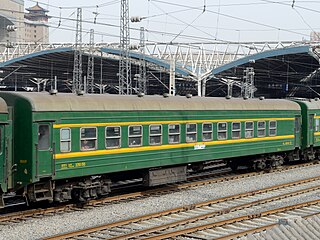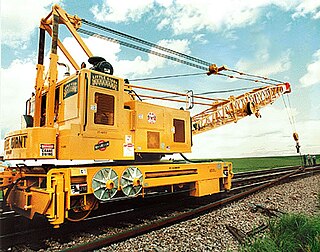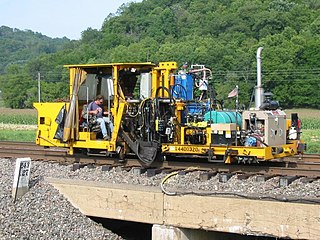
A railroad car, railcar, railway wagon, railway carriage, railway truck, railwagon, railcarriage or railtruck, also called a train car, train wagon, train carriage or train truck, is a vehicle used for the carrying of cargo or passengers on a rail transport network. Such cars, when coupled together and hauled by one or more locomotives, form a train. Alternatively, some passenger cars are self-propelled in which case they may be either single railcars or make up multiple units.

A railway track or railroad track, also known as a train track or permanent way, is the structure on a railway or railroad consisting of the rails, fasteners, railroad ties and ballast, plus the underlying subgrade. It enables trains to move by providing a dependable surface for their wheels to roll upon. Early tracks were constructed with wooden or cast iron rails, and wooden or stone sleepers; since the 1870s, rails have almost universally been made from steel.

Maintenance of way refers to the maintenance, construction, and improvement of rail infrastructure, including tracks, ballast, grade, and lineside infrastructure such as signals and signs.

A railway crane is a type of crane used on a railway for one of three primary purposes: freight handling in goods yards, permanent way (PW) maintenance, and accident recovery work. Although the design differs according to the type of work, the basic configuration is similar in all cases: a rotating crane body is mounted on a sturdy chassis fitted with flanged wheels. The body supports the jib and provides all the lifting and operating mechanisms; on larger cranes, an operator's cabin is usually provided. The chassis is fitted with buffing (UK) and/or coupling gear to allow the crane to be moved by a locomotive, although many are also self-propelled to allow limited movement about a work site.

Track ballast is the material which forms the trackbed upon which railroad ties are laid. It is packed between, below, and around the ties. It is used to bear the compression load of the railroad ties, rails, and rolling stock; to facilitate drainage; and keep down vegetation that can compromise the integrity of the combined track structure. Ballast also physically holds the track in place as the trains roll over it. Not all types of railway tracks use ballast.

A spike driver is a piece of rail transport maintenance of way equipment. Its purpose is to drive rail spikes into the ties on a rail track to hold the rail in place. Many different sizes of spikers are manufactured and in use around the world.
This article contains a list of terms, jargon, and slang used to varying degrees by railfans and railroad employees in the United States and Canada. Although not exhaustive, many of the entries in this list appear from time to time in specialist, rail-related publications. Inclusion of a term in this list does not necessarily imply its universal adoption by all railfans and railroad employees, and there may be significant regional variation in usage.
High-speed railway track construction is the process by which Lignes à Grandes Vitesses, the land on which TGV trains are to run, is prepared for their use, involving carving the track bed and laying the track. This construction technique is used both for the French TGV network and other TGV-based networks outside of France.

Pavonia Yard is a Conrail Shared Assets Operations (CSAO) rail yard in Camden, New Jersey.

A track geometry car is an automated track inspection vehicle on a rail transport system used to test several parameters of the track geometry without obstructing normal railroad operations. Some of the parameters generally measured include position, curvature, alignment of the track, smoothness, and the crosslevel of the two rails. The cars use a variety of sensors, measuring systems, and data management systems to create a profile of the track being inspected.

A ballast regulator is a piece of railway maintenance equipment used to shape and distribute the gravel track ballast that supports the ties in rail tracks. They are often used in conjunction with ballast tampers when maintaining track.

A tie crane or tie handler, is a piece of rail transport maintenance of way equipment used to move and handle the railroad ties used in rail tracks using track relaying. The machines are used as an alternative to the manual labor once used. Tie cranes frequently work with tie extractor/inserters to replace ties as part of a section gang.

A rail fastening system is a means of fixing rails to railroad ties or sleepers. The terms rail anchors, tie plates, chairs and track fasteners are used to refer to parts or all of a rail fastening system. The components of a rail fastening system may also be known collectively as other track material, or OTM for short. Various types of fastening have been used over the years.

Loram Maintenance of Way, Inc. is a railroad maintenance equipment and services provider. Loram provides track maintenance services to freight, passenger, and transit railroads worldwide, as well as sells and leases equipment which performs these functions.

A rail adhesion car or rail adhesion train is a modified vehicle used on a rail adhesion system where the standard equipment does not have locomotives' rail sanding ability. In particular, it may involve tanks and dispensing equipment installed in an electric subway or rail car that is run over the rails alone or in a train to dispense sand when needed. Because of space limits under the cars, the sand or gel/sand mix tanks are installed inside the passenger space.

A track renewal train is a work train that consists of many units of machinery and materials required for track renewal projects.

On the evening of July 18, 2013, a CSX freight train carrying municipal solid waste on tracks of the Hudson Line along the Harlem River Ship Canal in the New York City borough of The Bronx partially derailed between the Marble Hill and Spuyten Duyvil stations. While no one was injured, the derailment caused over US$800,000 in damage and took several days to clean up. Commuter rail service by Metro-North Railroad, which owns the line, was suspended for two weekends in order to fully restore normal operations.

A spike puller is a railroad maintenance of way machine designed to remove rail spikes from ties. The spike puller automates the task of spike removal, allowing it to be done at a rate greater than can be achieved by hand. Spike pullers range from small hand operated hydraulic machines to self propelled machines controlled by an operator in an enclosed cab.

Nordco, Inc. is an American manufacturer of railroad maintenance of way and inspection equipment, based in Oak Creek, Wisconsin. Founded in 1926, it has been a subsidiary of Wabtec since 2021. The company is one of the top manufacturers of railroad maintenance equipment in North America.























